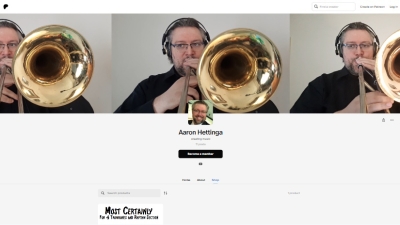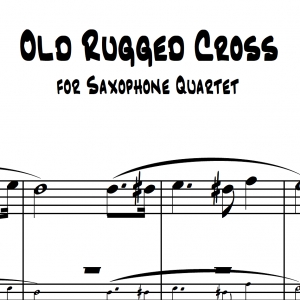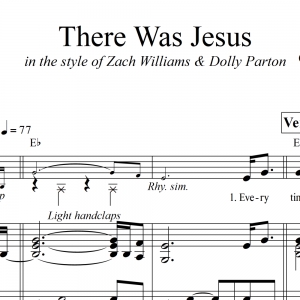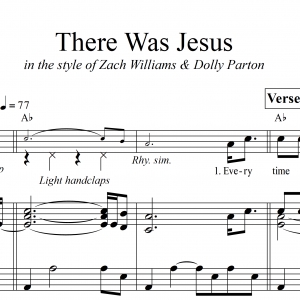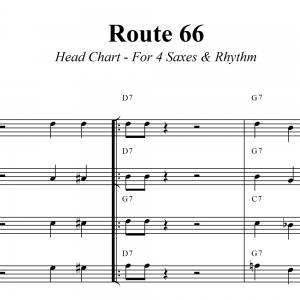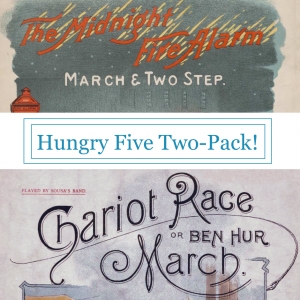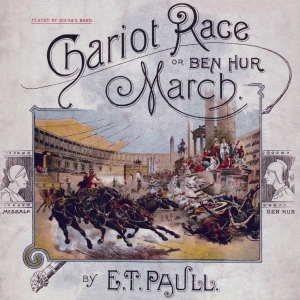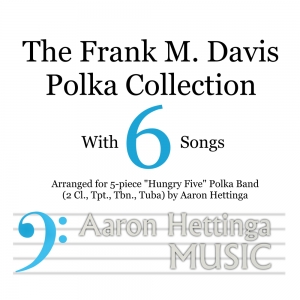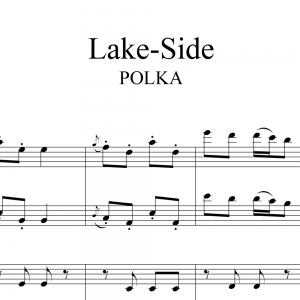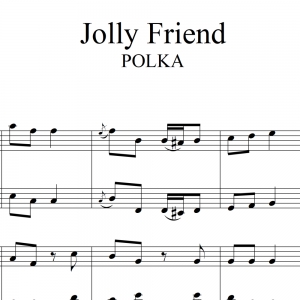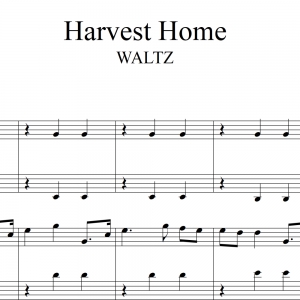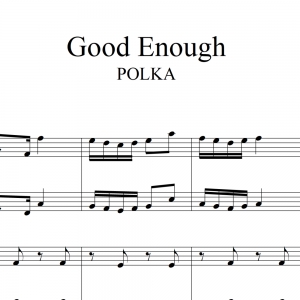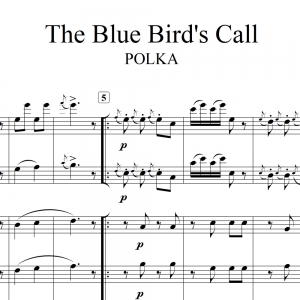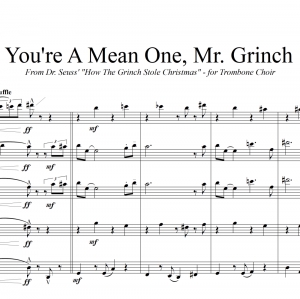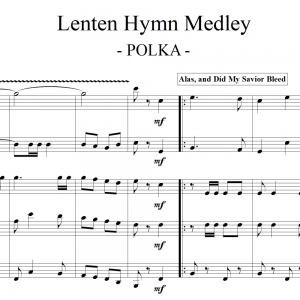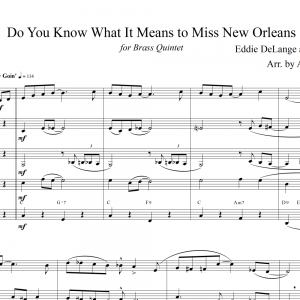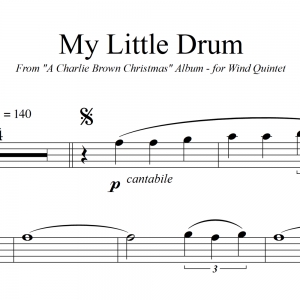
Aaron Hettinga
This setting of George Bernard's Classic Hymn, "Old Rugged Cross," for Clarinet quartet/choir takes a completely new approach harmonically in this arrangement. While the famous melody in the 1st clarinet has a few added embellishments, the rest of the ensemble joins with tighter jazz-influenced harmony.
A reflective approach to this piece of music would be extremely rewarding in a worship setting when used either as an offertory or as a lead-in to a music set. While none of the individual brass parts are particularly challenging, it will still be an exercise in balanced small ensemble playing.
Also available for Saxophone Quartet or Trombone Ensemble
This setting of George Bernard's Classic Hymn, "Old Rugged Cross," for Saxophone quartet takes a completely new approach harmonically in this arrangement. While the famous melody in the 1st Alto Sax has a few added embellishments, the rest of the ensemble joins with tighter jazz-influenced harmony.
A reflective approach to this piece of music would be extremely rewarding in a worship setting when used either as an offertory or as a lead-in to a music set. While none of the individual brass parts are particularly challenging, it will still be an exercise in balanced small ensemble playing.
For flexibility, while this arrangement was conceived as an AATB ensemble, a Soprano Sax sub part is included as an optional replacement of Alto 1 (SATB) or alternatively a second Tenor Sax can substitute for the Bari Sax (AATT).
Also available for Trombone Ensemble
My Favorite Things – inspired by Kelly Clarkson and arranged for Brass Quintet and Rhythm Section Set in the original key of Em. Also note that the string parts are optional and the keyboard part only has chord symbols. A synth/String Reduction part is included that covers all the string parts. This is fairly easy to play though it sounds tougher on the recording.
Also available with accompaniments for 3 Horns and Full Big Band
My Favorite Things – inspired by Kelly Clarkson and arranged for big band 5444 and (optional) strings 2111. Set in the original key of Em. *Note that this arrangement includes a clarinet and bass sax which should be considered optional. Also note that the string parts are optional and the keyboard part only has chord symbols. A synth/String Reduction part is included that covers all the string parts. This is fairly easy to play though it sounds tougher on the recording.
Also available with reduced accompaniments for 3 Horns and 5 Brass
This tender recording from Zach Williams & Dolly Parton is presented here in a TTBB Men’s Quartet/Choir arrangement. The lead sheet is included with this package.
In this arrangement, Dolly’s vocals effectively become the high tenor part and the lead singer takes on Zach Williams’ vocal. Baritone/Bass parts have been worked in on the Chorus.
This Piano part and Lead Sheet both conform to the original performance in form, but for this edition the key has been lowered to E-flat major. Vocal harmonies are cued above the full-sized notes of the melody. Dolly takes some liberties here and there, but not every inflection is notated every time.
Also available independently with only the Lead Sheet.
Additionally available as in a Lowered Key as a Lead Sheet or a Piano/Vocal arrangement.
This tender recording from Zach Williams & Dolly Parton is presented here in a TTBB Men’s Quartet/Choir arrangement. The lead sheet is included with this package.
In this arrangement, Dolly’s vocals effectively become the high tenor part and the lead singer takes on Zach Williams’ vocal. Baritone/Bass parts have been worked in on the Chorus.
This Piano part and Lead Sheet both conform to the original performance: same key and same form. Vocal harmonies are cued above the full-sized notes of the melody. Dolly takes some liberties here and there, but not every inflection is notated every time. The recording can be heard here: https://www.youtube.com/watch?v=37wV6D49iEY
Also available independently with only the Lead Sheet.
Additionally available as in a Lowered Key as a Lead Sheet or a Piano/Vocal arrangement.
This standard is available here for 4 horn Jazz Combo and Rhythm section.
This arrangement was written as a “Head” chart where, after the initial rundown of the melody, the form is repeated for as many soloists as are desired before a final repeat playing the tune and proceeding to the second ending. Chord changes are provided in all parts for flexibility in soloist selection. Optionally, the brief stop-time at measure 27 makes for a good place for the ensemble to come back in during a final solo and head on through the 2nd ending. Another performance option: It works well to start this tune with walking bass alone, horns come in at the head, then add full rhythm at measure 15 the first time..
This chart makes for a good opportunity for a jazz combo to perform this tune in harmony with a rhythm section.
Also available for Trombone Quartet or Saxophone Quartet and Rhythm
This standard is available here for 4 Saxophones (AATB) and Rhythm section.
This arrangement was written as a “Head” chart where, after the initial rundown of the melody, the form is repeated for as many soloists as are desired before a final repeat playing the tune and proceeding to the second ending. Chord changes are provided in all parts for flexibility in soloist selection. Optionally, the brief stop-time at measure 27 makes for a good place for the ensemble to come back in during a final solo and head on through the 2nd ending. Another performance option: It works well to start this tune with walking bass alone, horns come in at the head, then add full rhythm at measure 15 the first time..
This chart makes for a good opportunity for a sax quartet to perform this tune in harmony with a rhythm section.
Also available for Trombone Quartet or mixed Jazz Combo
This standard is available here for 4 Trombones and Rhythm section.
This arrangement was written as a “Head” chart where, after the initial rundown of the melody, the form is repeated for as many soloists as are desired before a final repeat playing the tune and proceeding to the second ending. Chord changes are provided in all parts for flexibility in soloist selection. Optionally, the brief stop-time at measure 27 makes for a good place for the ensemble to come back in during a final solo and head on through the 2nd ending. Another performance option: It works well to start this tune with walking bass alone, horns come in at the head, then add full rhythm at measure 15 the first time..
The lead trombone part requires high range capability up to a high “C” but all four prats remain appropriate to their roles in the section. This chart makes for a good opportunity for a trombone quartet to perform this tune in harmony with a rhythm section.
Also available for Saxophone Quartet or mixed Jazz Combo
Edward Taylor Paull (1858-1924) was an American composer of marches and rags who was successful in producing a large number of circus marches in the late 1800’s/early 1900’s.. The “Ben Hur Chariot Race March” was the first publication he released in 1894. He also arranged Harry J. Lincoln's hit, "Midnight Fire Alarm."
These arrangements have been prepared for the instrumentation of Alford’s “Hungry Five” polka band books and serve as a fine addendum to those familiar pieces. While the clarinet parts tend to be the most active, they often feature diatonic scalar patterns that remain accessible to most intermediate-level players. The trombone part here is more active than many other arrangements for this kind of ensemble and could also be handled by Euphonium if desired. Again, it’s mostly short diatonic 16th note bursts. At the risk of sounding sloppy, it may be better to take the tempo a little lesser than a circus march tempo to accommodate. Besides, if playing this piece for Polka dancing, it would be best to take this at a more danceable tempo anyway.
This downloadable PDF package contains 2 complete packages of full scores and a sets of parts for "Midnight Fire Alarm" and “Ben Hur Chariot Race March” that are ready to go for adding some extra variety to your German Band’s Oktoberfest OomPah gig!
Edward Taylor Paull (1858-1924) was an American composer of marches and rags who was successful in producing a large number of circus marches in the late 1800’s/early 1900’s.. The “Ben Hur Chariot Race March” was the first publication he released in 1894.
This arrangement has been prepared for the instrumentation of Alford’s “Hungry Five” polka band books and serve as a fine addendum to those familiar pieces. While the clarinet parts tend to be the most active, they often feature diatonic scalar patterns that remain accessible to most intermediate-level players. The trombone part here is more active than many other arrangements for this kind of ensemble and could also be handled by Euphonium if desired. Again, it’s mostly short diatonic 16th note bursts. At the risk of sounding sloppy, it may be better to take the tempo a little lesser than a circus march tempo to accommodate. Besides, if playing this piece for Polka dancing, it would be best to take this at a more danceable tempo anyway.
This downloadable PDF package contains a full score and a set of parts that are ready to go for adding some extra variety to your German Band’s Oktoberfest OomPah gig!
Also included as part of the E.T. Paull Hungry Five 2-Pack
This 70's-era gospel standard is presented here in a TTBB Men's Quartet (or Men’s Chorus) arrangement much in the style as performed by the Oak Ridge Boys. Besides the vocal and piano parts, this arrangement also includes the chord changes throughout (with guitar fretboards) and notated piano introduction.
Range-wise, there are a few things to watch for. The Bass part is intended for a very low voice going down to the low “C” below the staff, though it is cued in the higher octave. The Tenor line spends a good deal of time up at the “G” on top of the staff, and there is also a “Willie Wynn” - styled solo at the end that could feature a soloist up there.
A great addition to either celebratory worship services or special concert settings!
Also available as a stand-alone Lead Sheet
Harry James Lincoln (1878-1937) was an American composer of marches and rags. “Midnight Fire Alarm” was his first publication (released in 1900) which went on to become a hit upon the release of the piano and band arrangements done by Edward Taylor Paull (1858-1924), a composer/arranger/sheet music publisher who was successful in producing a large number of circus marches in the late 1800’s/early 1900’s.
This arrangement has been prepared for the instrumentation of Alford’s “Hungry Five” polka band books and serve as a fine addendum to those familiar pieces. While the clarinet parts tend to be the most active, they often feature diatonic scalar patterns that remain accessible to most intermediate-level players. The trombone part here is more active than many other arrangements for this kind of ensemble and could also be handled by Euphonium if desired. Again, it’s mostly diatonic 16th note bursts. At the risk of sounding sloppy, it may be better to take the tempo a little lesser than a circus march tempo to accommodate. Besides, if playing this piece for Polka dancing, it would be best to take this at a more danceable tempo anyway.
This downloadable PDF package contains a full score and a set of parts that are ready to go for adding some extra variety to your German Band’s Oktoberfest OomPah gig!
Also included as part of the E.T. Paull Hungry Five 2-Pack
Professor Frank Marion Davis (1839-1896) was an American educator, singer, and composer of both hymns and secular works. Among his secular works were a number of collections of polkas and waltzes written for solo piano. This series of works presents arrangements of a number of Davis’ compositions prepared for the instrumentation of Alford’s “Hungry Five” polka band books and serve as a fine addendum to those familiar pieces. While the clarinet parts tend to be the most active, they often feature diatonic scalar patterns. All parts should remain accessible to most intermediate-level players.
- The “Blue Bird’s Call” Polka (originally published in 1876) contains onomatopoeic chirps in the clarinet parts that make for a light and fun addition to any program.
- “Good Enough” Polka (originally published in 1874) is an example of Davis’ standard composition form used throughout most of this collection.
- “Harvest Home” Waltz (originally published in 1873) adds a pleasant waltz to the collection. Its melody is first presented simply,then embellishments are added as the piece continues.
- Davis’ aptly-titled “Jolly Friend” Polka (originally published in 1874) is a jovial tune with a bouncy melody that moves the clarinetists nimbly around a bit!
- “Lake-Side” Polka (originally published in 1874) has more participation in the Trumpet and Trombone parts than are found in much of the rest of this collection.
- “Nimble Toe” Polka (originally published in 1874) passes the melodic and accompaniment elements around the ensemble for a bit of variety for the players.
This downloadable PDF package contains a set of full scores and a set of folio-sized parts (2 songs per page) that are ready to go for your German band's Oktoberfest OomPah gig!
Also available individually as linked above
Professor Frank Marion Davis (1839-1896) was an American educator, singer, and composer of both hymns and secular works. Among his secular works were a number of collections of polkas and waltzes written for solo piano. This series of works presents arrangements of a number of Davis’ compositions prepared for the instrumentation of Alford’s “Hungry Five” polka band books and serve as a fine addendum to those familiar pieces. While the clarinet parts tend to be the most active, they often feature diatonic scalar patterns. All parts should remain accessible to most intermediate-level players.
“Nimble Toe” Polka (originally published in 1874) passes the melodic and accompaniment elements around the ensemble for a bit of variety for the players.
This downloadable PDF package contains a full score and a set of folio-sized parts that are ready to go for your German band's Oktoberfest OomPah gig!
Also available as part of the Frank M. Davis Polka Collection
Professor Frank Marion Davis (1839-1896) was an American educator, singer, and composer of both hymns and secular works. Among his secular works were a number of collections of polkas and waltzes written for solo piano. This series of works presents arrangements of a number of Davis’ compositions prepared for the instrumentation of Alford’s “Hungry Five” polka band books and serve as a fine addendum to those familiar pieces. While the clarinet parts tend to be the most active, they often feature diatonic scalar patterns. All parts should remain accessible to most intermediate-level players.
“Lake-Side” Polka (originally published in 1874) has more participation in the Trumpet and Trombone parts than are found in much of the rest of this collection.
This downloadable PDF package contains a full score and a set of folio-sized parts that are ready to go for your German band's Oktoberfest OomPah gig!
Also available as part of the Frank M. Davis Polka Collection
Professor Frank Marion Davis (1839-1896) was an American educator, singer, and composer of both hymns and secular works. Among his secular works were a number of collections of polkas and waltzes written for solo piano. This series of works presents arrangements of a number of Davis’ compositions prepared for the instrumentation of Alford’s “Hungry Five” polka band books and serve as a fine addendum to those familiar pieces. While the clarinet parts tend to be the most active, they often feature diatonic scalar patterns. All parts should remain accessible to most intermediate-level players.
Davis’ aptly-titled “Jolly Friend” Polka (originally published in 1874) is a jovial tune with a bouncy melody that moves the clarinetists nimbly around a bit!
This downloadable PDF package contains a full score and a set of folio-sized parts that are ready to go for your German band's Oktoberfest OomPah gig!
Also available as part of the Frank M. Davis Polka Collection
Professor Frank Marion Davis (1839-1896) was an American educator, singer, and composer of both hymns and secular works. Among his secular works were a number of collections of polkas and waltzes written for solo piano. This series of works presents arrangements of a number of Davis’ compositions prepared for the instrumentation of Alford’s “Hungry Five” polka band books and serve as a fine addendum to those familiar pieces. While the clarinet parts tend to be the most active, they often feature diatonic scalar patterns. All parts should remain accessible to most intermediate-level players.
“Harvest Home” Waltz (originally published in 1873) adds a pleasant waltz to the collection. Its melody is first presented simply,then embellishments are added as the piece continues.
This downloadable PDF package contains a full score and a set of folio-sized parts that are ready to go for your German band's Oktoberfest OomPah gig!
Also available as part of the Frank M. Davis Polka Collection
Professor Frank Marion Davis (1839-1896) was an American educator, singer, and composer of both hymns and secular works. Among his secular works were a number of collections of polkas and waltzes written for solo piano. This series of works presents arrangements of a number of Davis’ compositions prepared for the instrumentation of Alford’s “Hungry Five” polka band books and serve as a fine addendum to those familiar pieces. While the clarinet parts tend to be the most active, they often feature diatonic scalar patterns. All parts should remain accessible to most intermediate-level players.
“Good Enough” Polka (originally published in 1874) is an example of Davis’ standard composition form used throughout most of this collection.
This downloadable PDF package contains a full score and a set of folio-sized parts that are ready to go for your German band's Oktoberfest OomPah gig!
Also available as part of the Frank M. Davis Polka Collection
Professor Frank Marion Davis (1839-1896) was an American educator, singer, and composer of both hymns and secular works. Among his secular works were a number of collections of polkas and waltzes written for solo piano. This series of works presents arrangements of a number of Davis’ compositions prepared for the instrumentation of Alford’s “Hungry Five” polka band books and serve as a fine addendum to those familiar pieces. While the clarinet parts tend to be the most active, they often feature diatonic scalar patterns. All parts should remain accessible to most intermediate-level players.
The “Blue Bird’s Call” Polka (originally published in 1876) contains onomatopoeic chirps in the clarinet parts that make for a light and fun addition to any program.
This downloadable PDF package contains a full score and a set of folio-sized parts that are ready to go for your German band's Oktoberfest OomPah gig!
Also available as part of the Frank M. Davis Polka Collection
The Dr. Seuss holiday standard appears here for a 5+ piece Trombone ensemble. Other than some optional high or low octave moments in the Lead and Bass parts, most of this arrangement should remain accessible to groups of most any moderate ability level.
Flexibility: While there are five distinct parts, this arrangement will work its best with a larger ensemble. If only five players are available, the divisi minor 2nds in the second part could be treated like grace notes.
This chart has always brought on a good reaction from audiences, as well as players. A fun piece to add to your Christmas setlist!
For something totally different, here are four traditional Lenten hymns presented in a medley arrangement for the same instrumentation as Alford’s “Hungry Five” series of Polka band books. The hymns included in this medley are:
- “Alas, and Did My Savior Bleed”
- “At The Cross”
- “I Hear the Master Say”
- “Jesus Paid It All”
Ranges and technical passages for all instruments remain in reliable reach for even fairly young players. Parts have been prepared in 2 marching folio-sized pages per part, but are packaged onto single printable PDF pages. Ready to go for a change-up number on your German band's Oktoberfest OomPah gig or maybe in a Polka Mass!
This Mardi Gras classic is presented here in an arrangement for a Brass Quintet. The melody gets passed back-and-forth a bit to give most everyone a chance to.
Flexibility: The tuba part has lead sheet-style chord changes included in case your tubist is willing to be a little more free with the New Orleans bass line.
Difficulty: None of the horn parts are very range-intensive, so a younger group of players shouldn’t need to be intimidated by range requirements. A good vehicle to showcase a great standard!
Also available for Traditional Jazz Ensemble or Piano/Vocal/Guitar or Instrumental Soloist
Vince Guaraldi’s unique flavor of “Little Drummer Boy” as recorded on the timeless album “A Charlie Brown Christmas” is available here for Wind Quintet. The form and key of the original recording is adhered to. A listen to the original recording would likely be helpful in internalizing the necessary Latin style. While this piece features a fair number of jazz-influenced harmonies, it remains in straight time throughout so no young players would need to learn how to swing.
Notes: Though it may feel a bit tedious, the children’s voices from the original recording are rendered fully in the Horn part. Besides the bassoonist (who gets to play a number of interesting bass lines), all other players get a chance with either the melody or the solo piano part which gets passed around between the various players, solo at times or in harmony at others. A lower octave option is provided for one particularly high range section for the hornist.
Performance Options: At the end of the original recording there is a fade out at the end of the coda. This arrangement captures a bit of the light improvisatory nature of the recording’s playout with an open repeat. This may be a good opportunity to allow a flutist with some improvisation skills to open up for a few moments at the end.
This would be a great addition to the holiday book for a Wind Quintet with advancing players who have good dexterity on their instruments, but will still remain accessible for players and audience alike.



